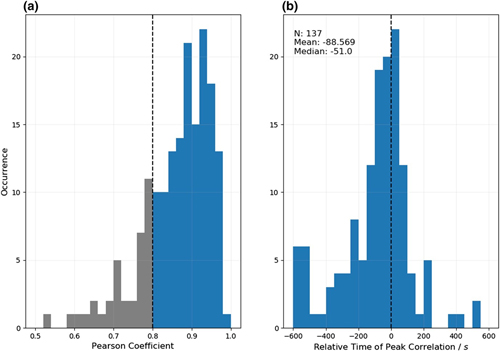
2020 THEMIS SCIENCE NUGGETS
On the Magnetospheric ULF Wave Counterpart of Substorm Onset
by Andy Smith
Mullard Space Science Laboratory, University College Londons
Introduction
The aurora forms a ring around the north and south magnetic poles of the Earth. During a “substorm,” the aurora can be seen to brighten dramatically and fill the sky, when seen from the ground. Auroral substorm onset is typically marked by the rapid brightening and poleward motion of the aurora. Smaller scale azimuthal structures, known as auroral beads, are frequently observed within the brightening auroral arc. These beads have been linked to simultaneous ULF (ultra-low frequency) fluctuations in the Earth’s magnetic field, with wave periods between 10 – 100s. The auroral brightness and ULF waves are both observed to grow exponentially in the few minutes leading up to auroral substorm onset, with evidence suggesting that this may be linked to a plasma instability in space. In our study we compared THEMIS ground observations with those in space on the night side of the Earth, to show that these ULF waves are generated in near-Earth space, before being transmitted to the ground.
Results
Using data from THEMIS A, D and E when they were conjugate to the Fort Smith (FSMI) ground station we showed that the magnetic ULF wave power grew exponentially over approximately 5-10 minutes in space and on the ground. At the same time, the auroral brightness also increased exponentially. Figures 1a- d show all-sky imagery from the FSMI ground station detailing the development of the auroral beads between 06:20 and 06:26, while Figure 1e shows a keogram displaying the northward/poleward motion of the aurora during this interval. Figure 1g shows the ULF wave power observed at the same location at the all sky imager; rapid growth of ULF wave power occurs at a similar time as the observations of the brightening arc and auroral beads. Meanwhile, Figure 1h shows the ULF wave power observed by the three THEMIS spacecraft. We can see that the wave power in space grows at a similar time as it does on the ground, perhaps leading the ground observations slightly. The growth of wave power is exponential in both locations, further corroborating the suggestion that a plasma instability in near-Earth space may be responsible.
| Figure 1. THEMIS ground and space observations during the onset of a substorm. Top row (a - d): four all sky images of the brightening auroral arc. Lower panels show time series of: north-south all sky keogram (e), all sky intensity (f), ground wave power (10 - 100s, g), space-based wavepower (10 – 100s, h), the SML and SMU magnetic indices. |
We then compared the ground and space observations statistically for THEMIS data during 176 substorm onsets in 2009. Figure 2 shows the results of the cross-correlation between the space- and conjugate ground-based wave power. Figure 2a shows that the observations often highly correlated with Pearson coefficients over 0.8, while Figure 2b shows that while there is a broad spread, on average the space-based observations lead the ground by an average of 1 – 1.5 minutes. This confirms that the waves likely originate in near-Earth space and can be seen by spacecraft before being observed on the ground.
| Figure 2. The results of cross-correlating the ground- and space-based observations during wave power growth, showing the Pearson coefficients (a) and the time of peak correlation (b). |
We also found that the spacecraft were most often ~ 10 RE downtail (1 RE = 6371 km) and in the pre-midnight sector when they observed enhanced wave power. The asymmetry across the nightside of the Earth may be related to the pre-midnight preference for other substorm phenomena and magnetic structures.
Conclusion
By combining THEMIS space- and ground-based observations we showed that the exponential growth of ULF waves in space and the exponential growth of auroral brightness observed on the ground are closely linked. The signatures in space are seen on average 1 – 1.5 minutes before the ground. The exponential nature of the growing wave power has previously been linked to plasma instabilities in space, while we do not explicitly study this instability, combining the observations in this way gives us new insights into the physical mechanisms at substorm onset.
Reference
Smith, A. W., Rae, I. J., Forsyth, C., Watt, C. E. J., Murphy, K. R. (2020). On the magnetospheric ULF wave counterpart of substorm onset. Journal of Geophysical Research: Space Physics, 125, e2019JA027573. https://doi.org/10.1029/2019JA027573Biographical Note
Andy Smith is a postdoctoral researcher at Mullard Space Science Laboratory (University College London). His research primarily focuses on magnetospheric processes at substorm onset and the impact of Space Weather on the ground.
 Please send comments/suggestions to
Emmanuel Masongsong / emasongsong @ igpp.ucla.edu
Please send comments/suggestions to
Emmanuel Masongsong / emasongsong @ igpp.ucla.edu


